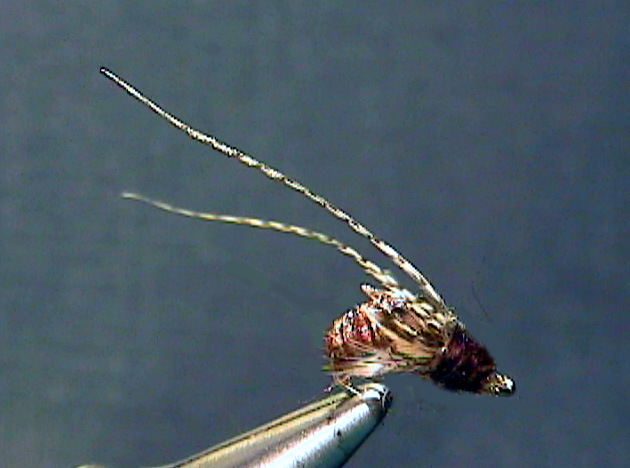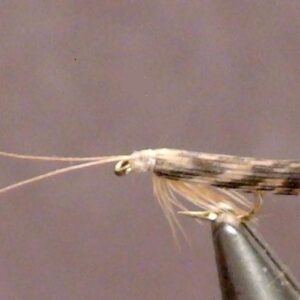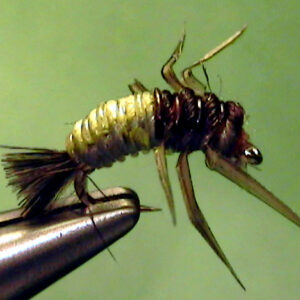Hook Size: 14/16
The Perfect Fly Spotted Sedge Pupa trout fly imitates the Spotted Sedge Caddis larva stage of life. Their larvae live in a case type shelter until the pupa is formed just prior to the hatch. Just prior to the hatch, the pupa comes out of its case and accents from the bottom of the stream to the surface where it emerges into an adult. This makes them easy prey for trout. They should be fished from the bottom to the surface of the water by first allowing the fly to sink to the bottom and then bringing the fly up to the surface using the current and the tip of the rod.
The Spotted Sedge (hydropsyche species) pupae are eaten by trout during the
hatch on a regular basis. It is the easiest time for the trout to consume the pupae
because they drift in the current for a relatively long time before reaching the
surface to emerge as adults. When it approaches the time of year for the
particular species of hydropsyche to hatch, the larvae will go in their shelters and
seal the openings. There they will proceed to spin a cocoon to use to pupate. It
takes about two or three weeks for them to form the pupa.
At the time the hatch begins, the pupa will eat its way out by chewing a hole in
the cocoon. It will then proceed to swim to the surface to hatch. This is the time
that the trout can easily pick off the pupae. They have no trouble eating the
helpless pupae drifting in the current trying to reach the surface to hatch.
These caddisflies emerge in moderate speed water. From the time they escape
their cocoon and begin their accent to the surface they are carried downstream
by the current. The pupae are in this helpless situation for some time. When they
reach the surface of the water, the pupal shuck splits and the emerged adult
caddisfly quickly flies away. The trout can also easily pick them off during the
time they are emerging from their pupa shuck in the surface skim. The bottom
line to this is that these caddisflies are eaten from the time they emerge from
their cocoon until they fly away to streamside foliage far more than any other time
of their life.
The emerging process usually starts late in the afternoons and continues until
well into the night. The egg laying activity of the adult females from previous
hatches will actually start during the time other caddisflies are emerging.
Imitating the Pupa:
You want to start fishing an imitation of the pupa late in the afternoon. These
caddisflies emerge from the riffles and runs of pocket water, and from the
moderate flowing water of smooth flowing streams. If you are catching trout on a
pupa imitation, then you should continue using it until you start seeing trout
eating the egg layers. This is usually very late in the afternoon, well after the sun
has set. At that time you may prefer to change to an imitation of the adult.
Some anglers fish the pupa imitation of the Spotted Sedge using a strike
indicator. Although this method will catch some trout, I think you would probably
be better off fishing without an indicator. If you are fishing smooth water, then I
suggest you use a down and across presentation. You may need to weight the fly
to help get it down. You should also mend the line a time or two to help get the fly
down. When the fly gets almost directly downstream of your position, just stop the
downstream drift by stopping the swing of the rod. The current will bring the fly to
the surface where you want to leave it for a few seconds.


